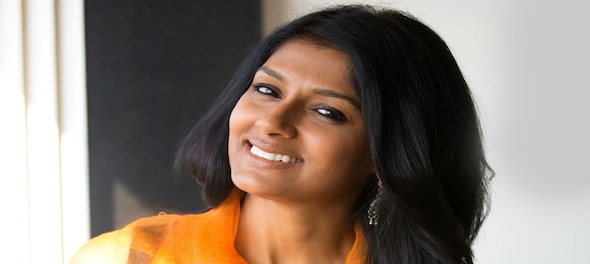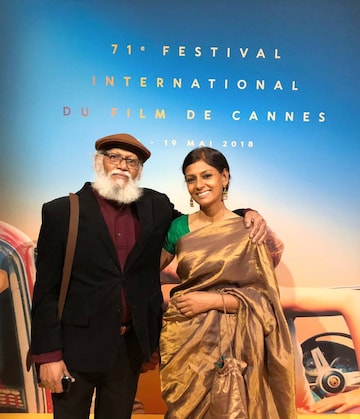
Nandita Das had come across the revolutionary writings of Saadat Hasan Manto while she was a student at Delhi University. “I was immediately struck by his simple yet profound narrative,” says the award-winning actor, artist and filmmaker, who did her Master’s in social work and committed herself to a life of a change agent early on.
The redoubtable Urdu writer, playwright and author born in British India has made a comeback in Nandita’s life as she releases her second directorial venture Manto. The biopic premiered at Cannes Film Festival after being one of 18 films shortlisted from over 2000 entries in the Un Certain Regard (which translates to ‘a certain glance’) category this May.
Read Here:
Manto is especially relevant in the modern Indian context – when the lines between patriotism and nationalism, religion and identity are increasingly being blurred.
Cannes 2018 was significant for Nandita for another reason: it was the first time that 82 female filmmakers, including Nandita, marched together on the red carpet to protest against the inequality and gender gap in cinema and society.
But for someone, who – two decades ago in the early stages of her career – had taken on nuanced roles on unmentionable subjects such as same-sex love (Deepa Mehta’s Fire), gang-rape (Jagmohan Mundhra’s Bawandar), baby harvesting (KNT Sastry’s Kamli) and Naxalism (Govind Nihalani’s Hazaar Chaurasi ki Maa), being fearless has become something of a habit.
Twice a jury member at Cannes Film Festival, and a recipient of France’s Chevalier dans l’Ordre des Arts et des Lettres, Nandita has certainly led an uncommon life. Now, as the first Indian to be inducted into The International Hall of Fame of the International Women’s Forum at Washington DC, she represents the Indian woman’s strength and power to the world.
She talks to us about her life, inspiration, and stories that need to be told.

Why did you decide to make a biopic on Manto? How relevant is he today?
What drew me to the story of Manto was his free spirit and his courage to stand up against orthodoxies of all kinds. I was struck by his simple yet profound narratives and the way he captured the people, politics and times he lived in. He was irreverent and had an irrepressible desire to poke a finger in the eye of the establishment.
For years, I thought of making a film based on Manto’s short stories, even before I made my directorial debut Firaaq in 2008. But it was only in 2012 that I began reading his essays.
The deeper I delved, the more convinced I was about the relevance of Manto in these times. More than 70 years later, we are still grappling with the issues of freedom of expression and struggles of identity. Our identities still lie inextricably linked to caste, class and religion instead of seeing the universality of human experience.
Firaaq won 20 awards and was critically acclaimed. Why did you wait so long before starting work on your second directorial venture?
I had no plans of doing any film after Firaaq. In the last 10 years, I have been busy doing many things: I wrote, directed and performed a play called Between the Lines. I was the chairperson of the Children’s Film Society for three years (which I probably took more seriously than I needed to!), I was selected as one of the 16 World Yale Fellows and did several speaking engagements.
I also wrote a monthly column for The Week for eight years and of course was busy raising my son. I have been used to doing many things simultaneously.
Maybe only after 40 films and 20 years of being on the fringes of the film industry, and four years of research and writing that I was equipped, emotionally and creatively, to tell Manto’s story that I felt so needed to be told.
Manto’s feminist views were considered offensive in his time – and perhaps still are to some. What did you learn about this side of him during your research?
Manto’s view of women was rare in literature of that time. It is one of the most important aspects of his work that has definitely interested me. The women in his stories were complex and richly developed, but he reserved his most nuanced and sympathetic gaze for sex workers, who were very much on the margins. He turned them from objects of scorn to people with agency; they were often the protagonists of his stories.
In his life, too, he was surrounded by women he loved and cared for – his mother, sister, wife and three daughters. He ironed his wife’s sari, made pickle, cleaned the house, read stories to his wife and sister, and was an engaged father. A rarity for South Asian men, even today!
Are you an actor, director or activist first?
I have always seen my work as a means to an end, my way to respond to the world.
I did my Master’s in social work and was happy working in Delhi bastis with young girls and women. Both acting and direction happened by accident. That said, films have provided me with a creative opportunity to share my concerns and use the platform to have conversations about things that matter. So in the end, film work and social advocacy are not that different for me, just different means for the same end.
How has your father’s work impacted you as an artist/filmmaker?
I derive a lot of my convictions and courage from my father, Jatin Das. A maverick who never became a part of the art market, was never was driven by money, is bound to be a misfit. My father’s fearlessness and courage to live his truth have given me the strength to make films true to my conscience. Creatively too, my upbringing exposed me to art and aesthetics from a very young age. I am not a trained actor or director so the home influences, especially from my father, have deeply impacted my choices in life.
At Cannes this year, you joined in a protest against the gender gap at the Cannes Film Festival with 81 other film personalities. What is the situation in India at present?
I am delighted to be part of that 5% who have had that honour to walk the red carpet, marching alongside 81 other women, a reminder of the inequality in cinema and society at large, which is shameful on many levels. It is reflective of the historical wrong and bias that is still prevalent in the most modern parts of the world. Some of us hoped the #MeToo and #TimesUp movements would hit Indian shores harder, exposing the open secrets of Bollywood and of every other profession where men have misused their power to harass and assault women.
Unfortunately, the murmurs have been too low. The few women who did speak out were predictably ostracised. Often, abuse was given the colour of being consensual, silencing the ripples even before they could become a wave. Despite the low murmurs, I hope that we will find a way to be heard. The onus needn’t only be on women to speak up, joining the #MeToo campaign. Our dream for an equal world must be seen collectively, a call to action because the #TimesUp.
Do you think things have changed for women in the film industry in India?
Things are changing but there is still a long way to go. In India, there is still a deafening silence primarily because women feel more vulnerable in a patriarchal society and a male-dominated industry, and fear being ostracized and further attacked. When a project is submitted, the question is still asked – who is the hero? An A-list actress will never have an A-list actor playing opposite her if she’s playing the lead. While the opposite happens all the time. These things take time to change.
Female actors are still stereotyped in their portrayals – to be perpetually good-looking (read sexy, if they are young, which they invariably need be) and their careers are still much shorter than their male co-stars, who at 50 can play college boys.
Having said that, definitely more and more women are now behind the camera so there is a little more representation and diversity in filmmaking. It is still far from enough, though. Stories exploring issues more central to women are increasing, though every other film continues to focus on ‘sexual freedom’ by showing female characters in sexy clothing, a continued pandering to the male gaze.
Quoting a journalist reviewing one such film, “(the women) remain slaves to their vanity kits and costume designers.” So yes, things are changing, but much more needs to happen and ideally much faster.
What are your thoughts on the Dark & Beautiful campaign you were part of?
I have supported many campaigns, for organ donations, signed petitions against genetically modified crops and to save the RTI from being wrongly amended. Dark & Beautiful is one that tells you to be comfortable in your skin. When I supported this campaign, I didn’t realize that it would go viral. I was also clueless about it from social media as I am not very active on it. I received a number of mails, from women mostly, sharing their stories of discrimination and feeling validated by this campaign.
I believe it is important to speak up and add one’s voice to campaigns for the larger good. After all, we are nothing but a drop in the ocean, but we need every drop to fill it!
What has been the best piece of advice you’ve been given?
“Don’t look back at what you couldn’t do. Be calm and focus on what you can do.” I tried this while making Manto. It was not only a creative journey, but a spiritual one too. I’m still working on it, but I’m happy to have found a way to be kinder to myself and others.
Check out our in-depth Market Coverage, Business News & get real-time Stock Market Updates on CNBC-TV18. Also, Watch our channels CNBC-TV18, CNBC Awaaz and CNBC Bajar Live on-the-go!


Telangana CM violated poll code, defer Rythu Bharosa payment, says Election Commission
May 7, 2024 9:01 PM
Lok Sabha Election 2024: How Indian political parties are leveraging AI
May 7, 2024 6:59 PM

